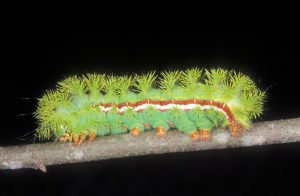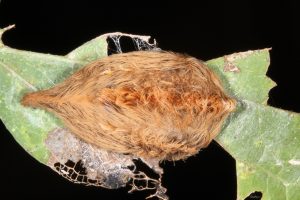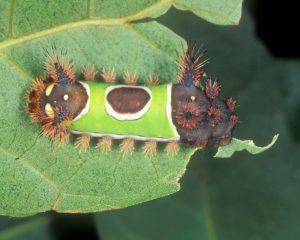Summer is in full blast, and I wanted to reissue some information on the topic of stinging caterpillars. When you think of caterpillars, you think of worm-like leaf-eaters that are generally harmless to humans. Caterpillars may be hairless, fuzzy like a wooly bear or even tufted with hair – almost inviting you to touch them. But there are “stinging” caterpillars in Florida that should not be touched. To touch any of the different kinds of stinging caterpillars found in Florida can become a painful experience. Beware the “Big 3” – the Io moth caterpillar, the saddleback caterpillar, and the puss caterpillar.

Stinging caterpillars have spines tipped with venom known as urticating spines. Many people who touch these caterpillars experience itching or burning; others may have severe reactions that require medical attention. Io moth caterpillars are brightly colored spiny larva. These large (around two and one-half inches long) caterpillars are pale green with white and red stripes and seem to be the most common venomous caterpillars found in Charlotte County. Their spines are yellow with black tips that occur on fleshy bumps covering the body. Io caterpillars may be found feeding on hibiscus, certain palms, and Royal Poinciana, as well as a variety of other plants including wax myrtle. The adult is a colorful and stunningly beautiful giant silk moth, yellow to orange in color, complete with eyespots on the hind wings.

Another strange venomous caterpillar is called the puss caterpillar which is also known as the southern flannel moth. The adult moths are very fluffy and soft in appearance – the Persian cats of the moth world! Up to one inch in length, the gray or brown caterpillars look like walking hair pieces totally covered in what appears to be soft hairs. Scattered amongst the soft hairs are the urticating spines. Severe pain can be the result of touching this caterpillar when the toxic spines break off in the skin. The toxicity of the sting will tend to increase as the caterpillar grows – it is known as one of the most venomous caterpillars in the U.S. Keep an eye out for them on oaks and elms.

In addition to the Io moth, Saddleback caterpillars also give clues that caution is required with bright colors and bristly hairs. This insect larva is brown with a green mid-section outlined in white. A gap in the center of the back gives the entire pattern the appearance of a saddle. The adult moth is small and drab and otherwise unremarkable. Saddlebacks may be found on dozens of plants including viburnum, Brazilian pepper, a variety of different palms, hollies, hibiscus and Podocarpus.
Fortunately, many of these stinging caterpillars are plagued with natural enemies that keep them under control including parasitic wasps and flies. If you are stung by these caterpillars, the literature suggests that placing common transparent tape over the affected area and striping off the irritating hairs that stick to the tape will help. Applications of ice will help relieve the pain. As mentioned earlier, if the person stung has excruciating pain, asthma, or allergic reactions, obtain medical help immediately.
Stinging caterpillars are part of nature that you may encounter in your landscape or natural areas. Knowing a little more about them will help keep you safe this summer – situational awareness and avoidance are the best recommendations! For more information on all types of stinging creatures in our area, or to ask a question, you can also call the Master Gardener Volunteer Helpdesk on Mondays, Wednesdays, and Fridays from 1 to 4 pm at 764-4340 for gardening help and insight into their role as an Extension volunteer. Ralph E. Mitchell is the Director/Horticulture Agent for UF/IFAS Extension – Charlotte County. He can be reached at 941-764-4344 or ralph.mitchell@charlottecountyfl.gov. Connect with us on social media. Like us on Facebook @CharlotteCountyExtension and follow us on Instagram @ifascharco.
Resources:
Perry, R. & Dale, A. (2018) Stinging and Venomous Caterpillars. The University of Florida Extension Service. IFAS.
Hall, D. W. (2021) IO MOTH AUTOMERIS IO (FABRICIUS) (INSECTA: LEPIDOPTERA: SATURNIIDAE). The University of Florida Extension Service. IFAS.
Hall, D. W. (2022) Puss Caterpillar (Larva), Southern Flannel Moth (Adult),Megalopyge opercularis (J. E. Smith 1797) (Insecta: Lepidoptera: Zygaenoidea: Megalopygidae). The University of Florida Extension Service. IFAS.
Bibbs, C. S. & Frank, J. H. (2021) Saddleback Caterpillar Acharia stimulea (Clemens) (Insecta: Lepidoptera: Limacodidae). The University of Florida Extension Service. IFAS.
 0
0
